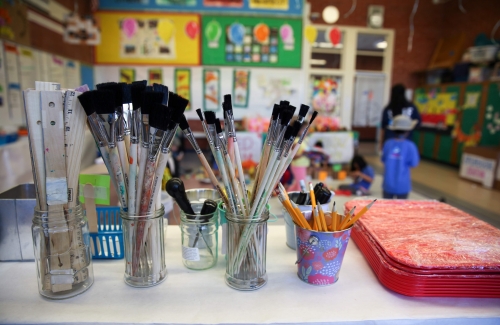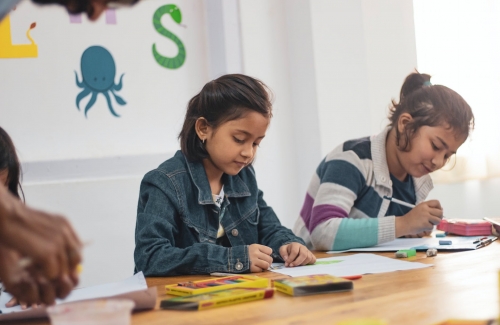School Supply Shopping Tips to Set Kids Up for Success

Who doesn’t love school supply shopping? No matter your child’s feelings on the return to school post-summer, there’s just something inherently thrilling about a brand new binder and a fresh box of colored pencils. A notebook is not just a notebook, but an item of opportunity and untold potential.
With so many options for each item, it’s no wonder that even the most excited parents and kids can feel daunted by back-to-school shopping. However, a little pre-planning can ease the strain, keep costs low, and start the school year off on a great note.
School Supply Shopping Tips for Families
The degree to which you involve kids will depend largely on the amount of time available to devote to the process. If you consider the errand as an investment, spending some dedicated time with kids in the weeks leading up to the start of school could save you a bit of money and teach them some useful life lessons.
#1: Start with a list.
Your child’s school supply list may arrive with their class assignment notification. Some teachers post their supply request lists on the school website or may even register their list with stores in the area. Often, major retailers have these suggested lists available in-store and online by teacher’s name for nearby schools.
If a student’s assigned teacher has not provided a list, retailers also have generic lists that itemize suggested supplies for various age ranges. Keep in mind that these lists are just suggestions to guide your purchases. If you are shopping for multiple kids, combine their lists for efficiency.
#2: Distinguish between needs and wants.
The difference between needs and wants is Econ 101, but kids may not get this right away. Help them decide whether an item is so important that they cannot complete their assignments without it, or if it is something extra that would be nice to have. Designate the “want” items on the list as something to consider once all of the “needs” have been purchased.
#3: Estimate a budget.
While basic supplies can usually be obtained quite reasonably, some of the extras can be pretty pricey. Elaborate backpacks, lunch bags, and locker accessories can be very enticing—and expensive. Creating a budget and doing some comparison shopping are valuable financial literacy lessons that kids can apply to these small purchases and that will help them to make more informed decisions later in life.
#4: Review sales together.
These begin to appear pretty early in the summer. Each week, retailers typically advertise with loss leaders. Those are products priced below cost to get customers in the door—think five spiral notebooks for $1.00.
If you start looking midsummer and have time for a weekly shopping trip, you can take advantage of those loss leaders, as well as weekly discounts, to save a bit of money.
To get kids in on the action, assign them the task of identifying the great deals on items from their list each week or comparing prices from different retailers in your area. Weekly advertisements are available in-store, in newspapers, and online.
#5: Research electronics carefully.
One of the top school supply shopping tips is to be extra careful with big-ticket items. If you’re investing in a laptop, tablet, or graphing calculator, think of it an opportunity not only to model comparison shopping for your kids, but also for teaching them skills to research the best model for the price. This provides an opportunity for an important lesson in media literacy as you help kids decide what constitutes a reliable review or recommendation.
#6: Make customizing supplies a creative activity.
The plainest supplies are often the cheapest—and the most customizable. These basics provide amazing blank canvases for kids to flex their creative muscles and individualize their supplies.
- A simple notebook can make a great easel for a young Sharpie artist.
- Washi tape can liven up a boring old pencil.
- Experiment with collage to make one-of-a-kind book covers.
Kids may be resistant at first to the idea of getting less flashy supplies, but their final results are sure to be creations that no one else has. Furthermore, they can take pride in knowing that they transformed something basic into a work of art.
#7: Decide what to do with the money you save.
Consider talking to your kids about families who may be unable to purchase supplies for the start of the school year. Most retailers offer options to donate supplies to kids and families who need them. Picking out supplies to donate with the money saved can be as much fun for kids as picking out their own supplies.
Another option is making a family donation to Donorschoose.org. These classroom projects are created by teachers in high need communities and may include school supplies, books, sports or lab equipment, and more. The start of the school year is a great time to donate, but contributions are accepted year-round.
Doing It Together
The back-to-school transition can be a wonderful opportunity for some real-world learning in the context of school supply shopping. And who better to help kids learn about financial and media literacy than parents, who can share their own experience and expertise.
This exciting time in kids’ lives is also a fantastic chance to reflect on their experiences and opportunities and to support others in their community. These shared activities are a powerful way to bring a summer of camp and learning to a close and usher in what is sure to be another wonderful school year.

 Kick the Back to School Blues With These Helpful Tips
Kick the Back to School Blues With These Helpful Tips  Getting Kids to Talk (And Keep Talking) About Their School Day
Getting Kids to Talk (And Keep Talking) About Their School Day  Getting Kids to Try New Things: Strategies That Really Work
Getting Kids to Try New Things: Strategies That Really Work 